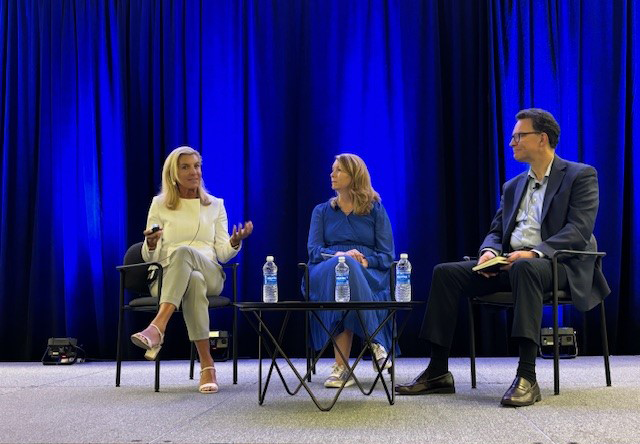No rest for the weary: Difficult times continue to present challenges for retailers and manufacturers.
Earlier this month, the dreaded word “recession” led news stories following a grim jobs report and subsequent stock market dive.
While more-recent economic data and reports tempered the specter of a recession, shoppers continue to feel the persistent pinch of inflation. They’re reining in spending as a result, and they’re changing their shopping habits to make their dollars stretch further.
But it’s not all doom and gloom for the retail industry. Retailers and consumer product manufacturers are deploying myriad strategies to drive sales and consumer loyalty — even in tumultuous times, says Jill Blanchard, president of intelligence and insights for Advantage Solutions.
Advantage, which serves as a strategic advisor and provider to CPG brands and retailers, has been shepherding many of them through the turbulent economy and shifting consumer preferences.
Blanchard, speaking on a panel at the National Association of Chain Drug Stores’ Total Store Expo in Boston on Monday, highlighted some challenges and opportunities in the marketplace, sharing insights from the quarterly Advantage Outlook report. Joining her on the panel were Rachel Marler, U.S. chief customer officer at Haleon and Stephen Carrou, executive sales director, Alcon U.S. OTC Business.
Here are six key takeaways from Blanchard’s presentation:
Value. Value means different things to different consumers. Bottom line: Most consumers are shopping with value front-of-mind. Some are trading down in categories and brands, while others are shopping larger pack sizes for a better price, Blanchard says. For retailers, a growing focus on private brands is proving prescient in offering consumers with the value they’re seeking, she notes. And both retailers and manufacturers are focused on more promotions and larger pack sizes.
“We hear a lot about inflation, but consumers aren’t created equal, so manufacturers and retailers have to cater to more than one strategy to meet shoppers’ value needs,” Blanchard says.
Innovation. It’s back! But it’s also unclear how it will play in the current economy.
More than one-third of manufacturers are hitting the gas on their innovation pipeline, but retailers are less bullish — only 13% say they’d be taking on more national brand innovation. In contrast, 28% of retailers say they’re committed to taking on more private brand innovation. Additionally, retailers want to see more value-priced innovation than what manufacturers say they’re bringing to market.
Theft-related shrink. Yep, it’s still a problem — for retailers, manufacturers and, ultimately, consumers. The 2Q 2024 Advantage Outlook found that retailers are continuing to rely on video surveillance and in-store security personnel to deter theft. They also plan to discontinue some products, particularly in the more expensive, smaller-package categories, such as cosmetics and facial, ear and eye care. This is an unfortunate outcome, Blanchard says, because discontinuing these products doesn’t solve the problem of serving shoppers.
“Until there’s an improved ability to identify and restrict the online sale of stolen items and thwart theft, we’re going to have to address this by-store, by-item,” Blanchard said.
Test-and-learns. When it comes to finding winning strategies, the test-and-learn is an essential tactic that allows retailers and manufacturers to measure the potential of new products or sales approaches before fully implementing them. Retailers are executing more test-and-learns than manufacturers, with three-quarters testing pricing promotions and nearly two-thirds testing new items, according to the Advantage Outlook.
“Test-and-learns are more important today than ever, as retailers and manufacturers scramble to meet consumers in new and sometimes conflicting need states,” Blanchard says.
Omnicommerce priorities. First, the good news: Online sales remain strong, and both manufacturers and retailers are embracing omnichannel sales to grow their overall business. But there are ripe opportunities to improve the online shopping experience to convert more shoppers into consumers.
Both manufacturers and retailers say their top omnicommerce priorities are optimizing digital shelf content – which is as important as having the product priced and merchandised correctly in-store – and investing in retail media networks.
Differentiation is key. The overwhelming majority of retailers and manufacturers have strategies to win that are … remarkably similar. For manufacturers, it’s expanded distribution, innovation and promotions; for retailers, it’s loyalty programs, pricing, private brands and promotions.
“Not everyone can win employing the same strategies,” Blanchard says. “I wish they could, but that probably won’t happen. So, with similar plans and strategies, winning will require differentiation.”
How are manufacturers and retailers planning to differentiate? According to the Advantage Outlook, top differentiating strategies for manufacturers are new distribution and differentiated innovation, while retailers will focus on differentiated promotions and exemplary loyalty programs.
How will it net out? And will there be winners and losers? “Let’s see what happens,” Blanchard says. “We are rooting for all of them.”
Ultimately, success will be gauged by how retailers and manufacturers are able to earn and sustain the loyalty of shoppers amid continued economic challenges.




